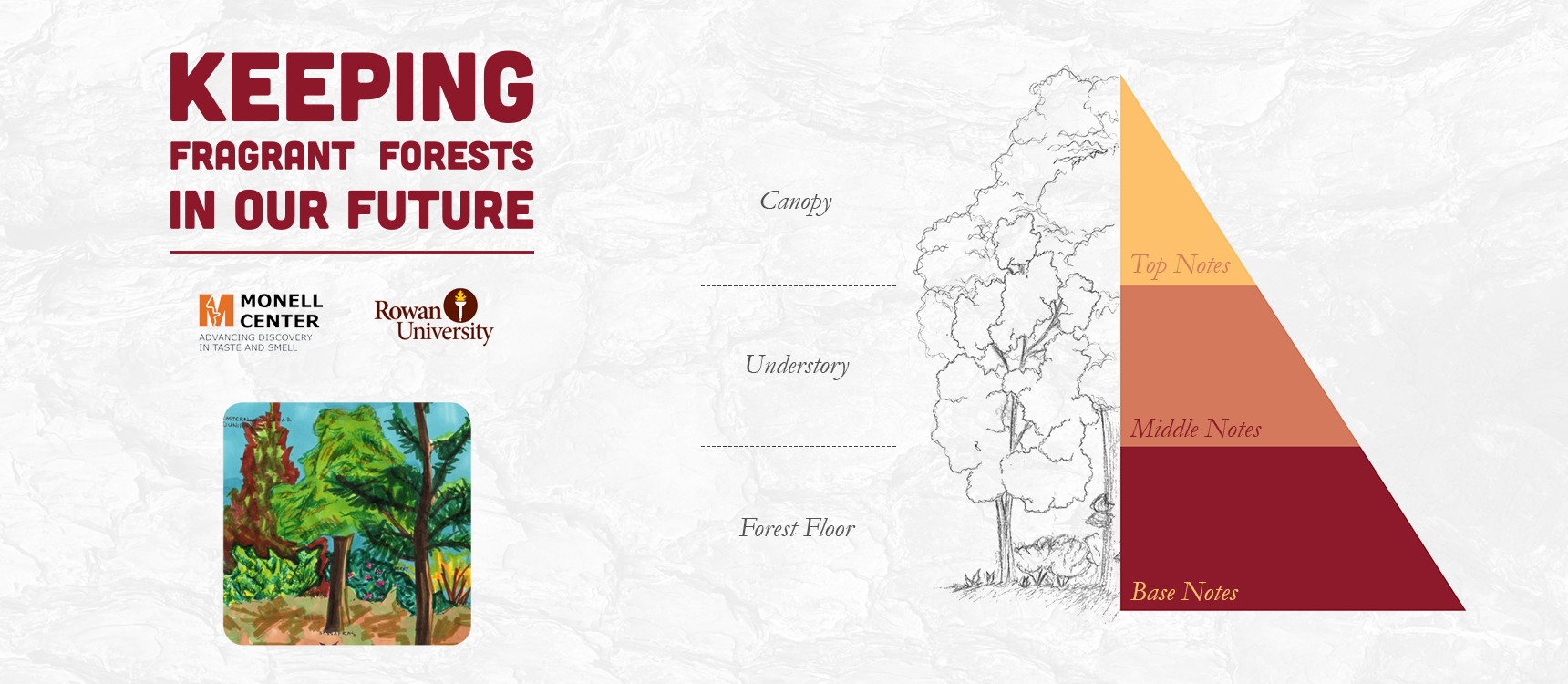smell fan
smell fan
Keeping Fragrant Forests in Our Future
Keeping Fragrant Forests in Our Future is an interdisciplinary olfactory art project in collaboration with Monell Chemical Senses Center which seeks to meld two analogous frameworks: the layers of the forest and the layers, or notes, of scents.
Forests and their fragrances are both comprised of distinct but interconnected layers - by bringing these two frameworks into conversation, we hope to spark conversation about the value of forests and their fragrances for humans and wildlife.
Getting to know the forest through your nose deepens appreciation of the natural environments we depend upon. Our forests have been under threat from human activities for some time, with many of the scents explored at the show being extracted from plants that commonly suffer from wildfires. The shared work of the students of Rowan’s Smell Studio and the Monell Chemical Senses Center aims to gain more insight into how natural odors affect human beings physically and mentally.
Rowan’s Smell Studio course annually exhibits a fragrance wheel with educational materials designed by students at the Philadelphia Flower Show. The annual showcase encourages attendees to reflect on the scents of nature, as well as the value of forests and the life they support.
Smell Walk Research: Black Run Preserve
Nose Training
The Monell Center supplied us with our odor reference kit, including their Monell Lexicon of 52 words to describe different fragrances. Students had to take a "nose dive" into this kit to familiarize themselves with the entire lexicon.
Data Collection
After becoming fully trained by the odor reference kit and the fragrance wheel, the Rowan students took their noses to the fragrant forest of Black Run Preserve in Evesham, NJ. Hiking bags packed, Smellders looked high and low for plants representative of New Jersey’s forest canopy.

We brought our knowledge of the Monell Lexicon and selected vials from the reference kit that are commonly found in nature. The ten chosen smells are then synthesized in the Monell Center’s lab for the attendees of the flower show.
Samples range between the fishy Reishi Mushroom, found growing on decayed wood and cooling, green pitch pine sap.

The Fragrance Wheel
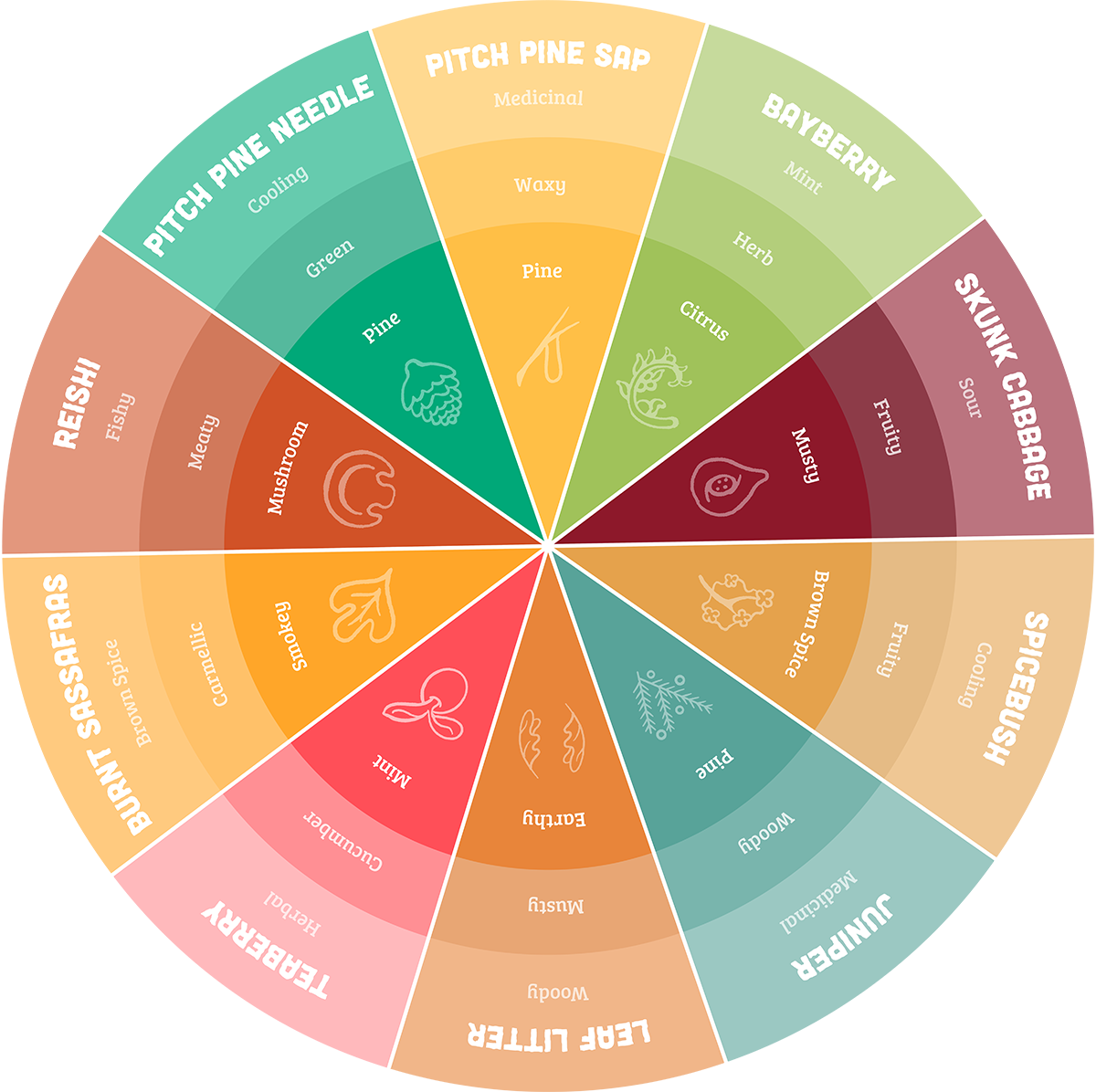
Students collaborated with each other to design a wheel for the Philadelphia Flower Show using the scents acquired in their smell walk, arranged into top, middle and base notes. Attendees of the show will spin the wheel and be provided with a paper strip to sample the scent provided by The Monell Chemical Senses Center. Fragrances represented on the wheel are commonly found within the forests of New Jersey and Pennsylvania.
The team also designed a pamphlet to guide participants through exploring nature through scent, which lists The Fragrance Wheel’s plants and scents are organized by the layers of the forest (canopy, understory, and forest floor.)
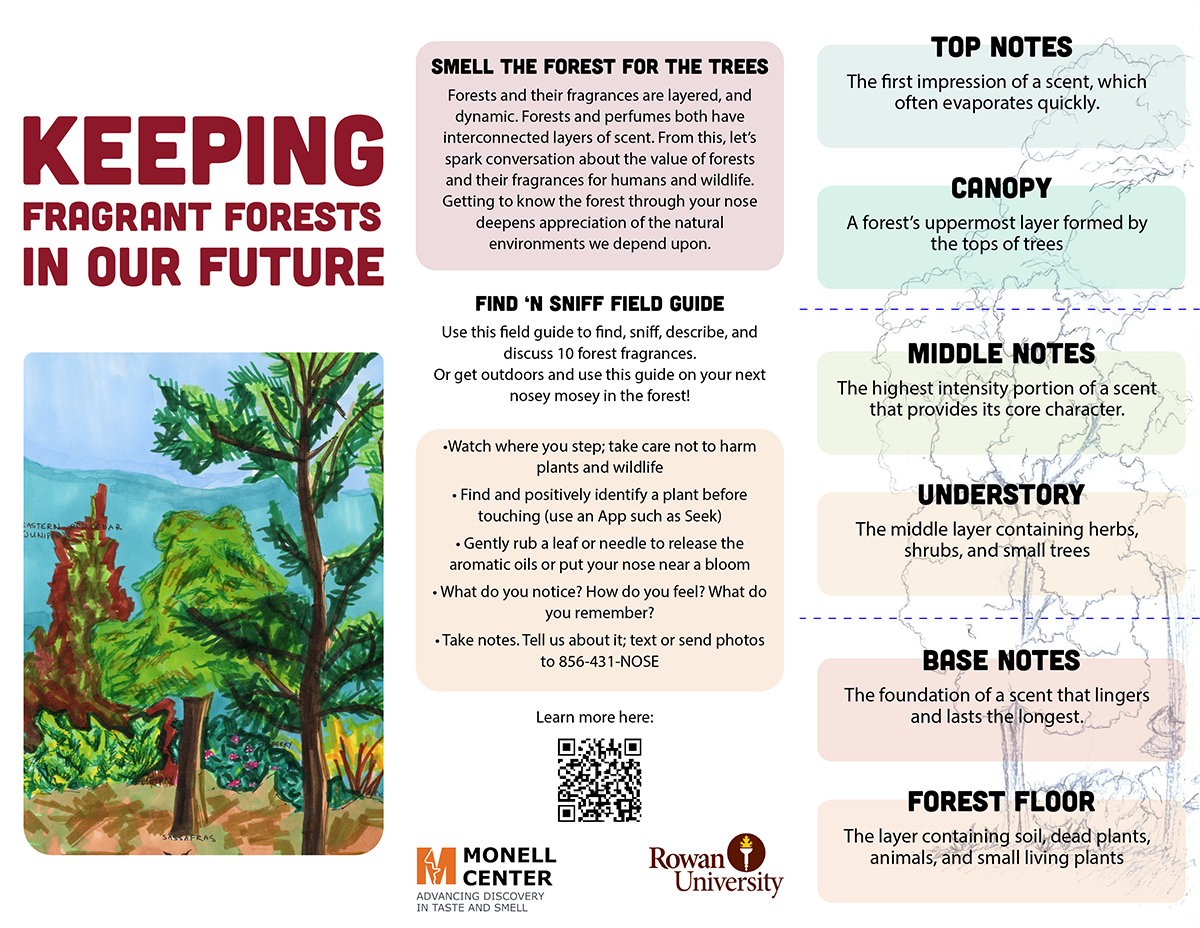
Acknowledgements
Smell Studio would like to thank the following people for their contributions to our project:
Professors & Faculty
Donna Sweigart
Dr. Jen Kitson
Design Team
Evert Willard
Jenipher Gronvold
Christian Palmisano
Gabrielle Margulies
Dominick Tran
Jillian Taylor
Intensive Research & Development Team
Chloe Ditzel
Avery Frieze-Dunfee
Christian Palmisano
Aedan Rosalia
Website & Communications
Misha Goldstein
Joseph Conte
Spencer Jordan
Aedan Rosolia
The Smell of Spring
About
The Smell of Spring is an interdisciplinary olfactory art project crafted to evoke the transient essence of spring through the use of thoughtfully curated scents. This collection draws inspiration from the local environment by featuring scents derived from endangered plants native to the Delaware Valley region affected by habitat loss and global warming. This project is done in collaboration with the Monell Chemical Senses Center; our team aims to contribute to the conservation and preservation of the ephemeral scents of spring.
This interactive public engagement, at the 2024 PHS Philadelphia Flower Show’s Family Frolic Day (Sunday March 3rd), effectively conveys local habitat threats through the, often overlooked, sense of smell. Our goal is to capture these scents before they vanish. Smell has the striking ability to transport us to specific moments and places defined by unique aromas.
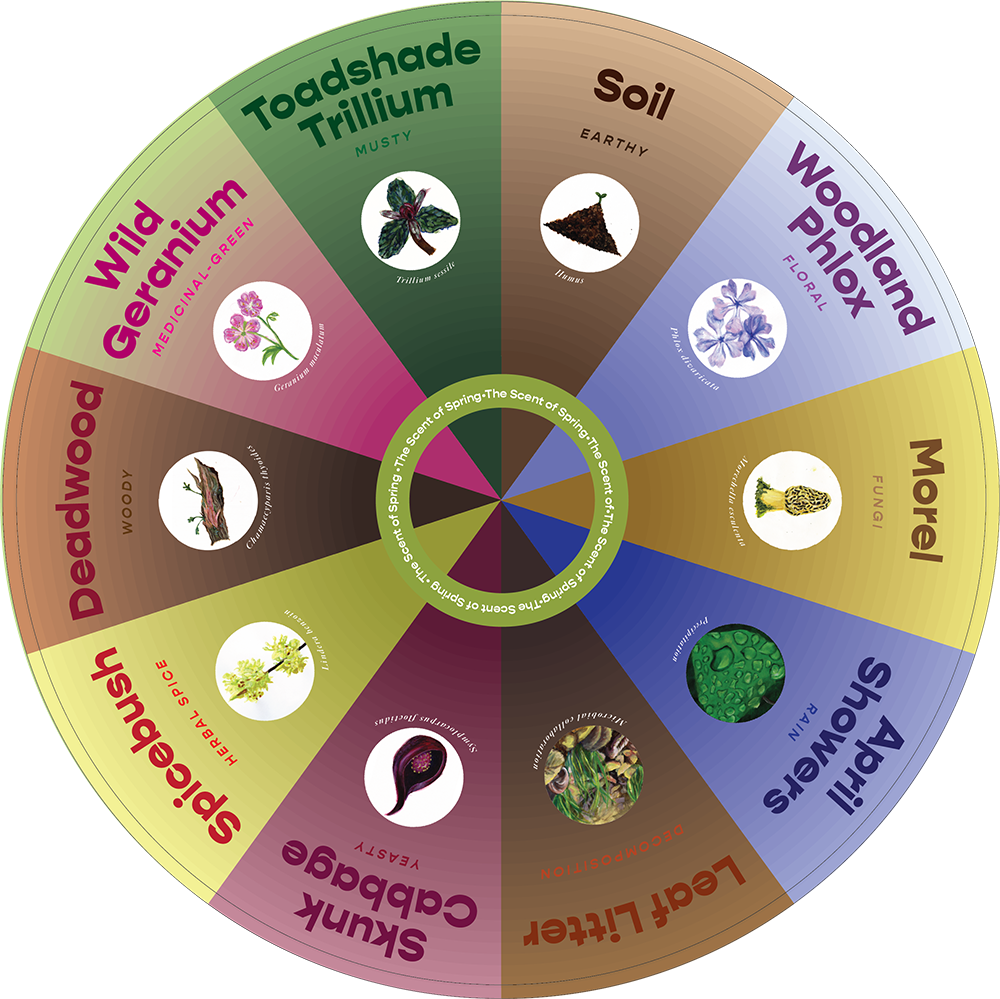
Attendees are invited to spin the wheel, and win a corresponding scent along with our new field guide cards. The card invites users to seek out the given scent within their environment by including a section for field notes; this allows participants to add their own individual observations.
Design Process
Smell Studio is a multidisciplinary team of students with backgrounds in graphic design, geography, environmental science, and fine art. Students collaborated by organizing themselves into teams; scent selectors, painters, designers, and foragers to utilize their strengths when crafting the exhibit. The experience consists of three interactive projects- the wheel of Spring Scents, take-home cards, and a poster poll.
First, the Scent Selectors decided which 10 native aromatic plants to showcase alternatives to the popular ornamental (non-native) plant selection at the flower show. The chosen scents highlight the significance of plants and decomposers' roles within curating a sustainable environment.
Then, Smell Studio visited the Monell Center to smell and select specific scent compounds that would be used to represent each native plant. Next, our painting duo visually represented the 10 chosen plants in their early spring form. Taking the baton, our design team used their graphic design expertise to fabricate a wheel design that would visually entice participants, considering the natural color schemes and common smell notes of each plant. The design team collaborated with team members with native plant knowledge to produce field guide cards for participants to take with them for further exploration. Finally, members of our team foraged environmental plant samples to compose a collaged poster for participants to share their ‘scent of spring’.
The Featured Scents:
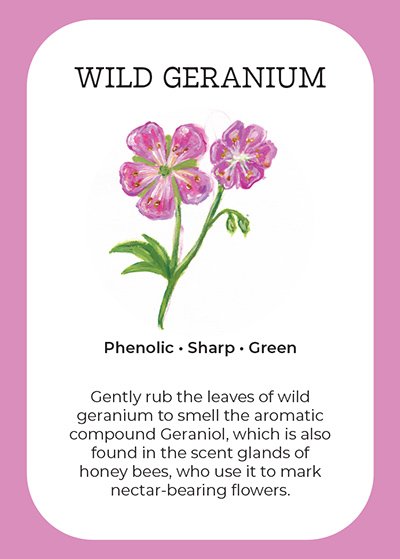 |
 |
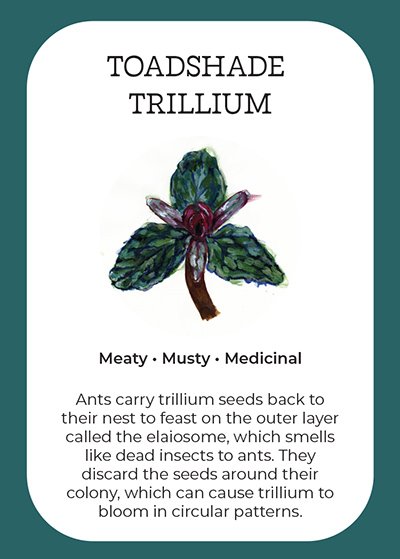 |
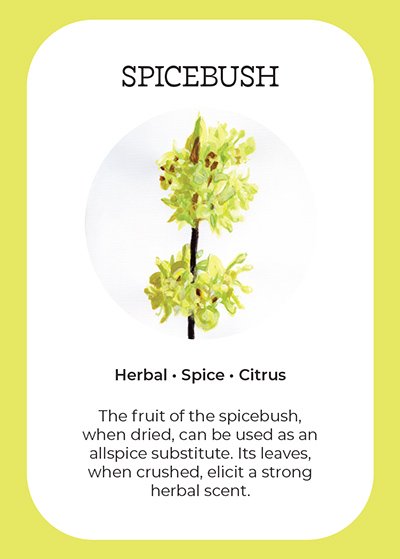 |
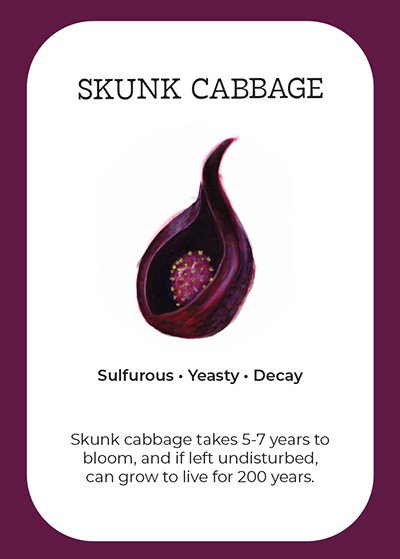 |
 |
 |
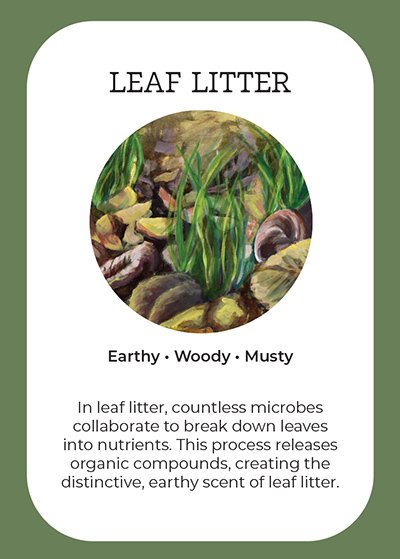 |
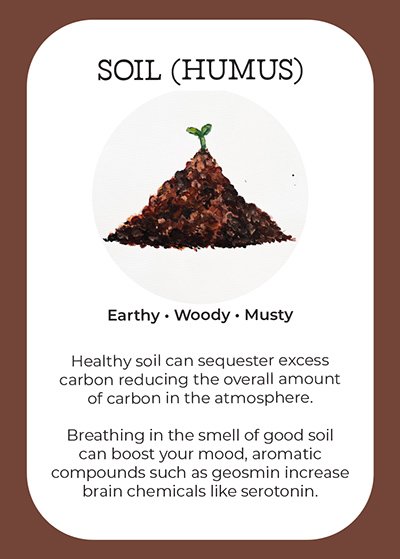 |
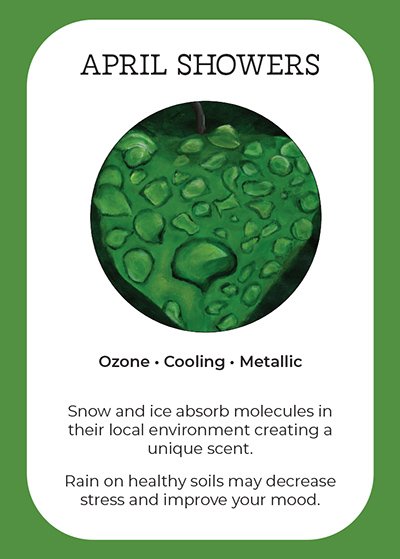 |
Wild Geranium (Geranium maculatum) – Medicinal-Green – (Phenolic, Sharp, Green) – Gently rub the leaves of wild geranium to smell the aromatic compound of Geraniol, which is also found in the scent glands of honey bees, who use it to mark nectar-bearing flowers.
Woodland Phlox (Phlox divaricata) – Light Floral – (Floral, Powdery, Sweet) – When in bloom, the small white-blue flower clusters of Phlox divaricata give off a floral scent with honey notes.
Toadshade Trillium (Trillium sessile) – Musty – (Meaty, Musty, Medicinal) – Ants carry trillium seeds back to their nest to feast on the outer layer called the elaiosome, which smells like dead insects to ants. They discard the seeds around their colony, which can cause trillium to bloom in circular patterns.
SpiceBush (Lindera benzoin) – Herbal Spice – (Herbal, Spice, Citrus) – The fruit of the spicebush, when dried, can be used as an allspice substitute. Its leaves, when crushed, elicit a strong herbal scent.
Skunk Cabbage (Symplocarpus foetidus) – Yeasty – (Sulfurous, Yeasty, Decay) – Skunk cabbage takes 5-7 years to bloom, and if left undisturbed, can grow to live for 200 years.
Morel (Morchella esculenta) – Fungi – (Mushroom, Fishy, Musty) – Morel mushrooms are prized edible mushrooms known to grow in-mass after wildfires! Kennett Square, PA is considered the mushroom capital of the world; explore the mushroom history of this area.
Deadwood (decomposing Atlantic White Cedar) – Woody – (Earthy, Woody, Musty) – Atlantic White Cedar was a widely dispersed tree in this region, but due to saltwater intrusion, their numbers have slowly declined. Smell them while you can!
Leaf Litter (Microbial collaboration) – Decomposition – (Earthy, Woody, Musty) – In leaf litter, countless microbes collaborate to break down leaves into nutrients. This process releases organic compounds, creating the distinctive, earthy scent of leaf litter.
Soil (Humus) – Earthy – (Earthy, Woody, Musty) – Healthy soil can sequester excess carbon, reducing the overall amount of carbon in the atmosphere. Breathing in the smell of good soil can boost your mood, aromatic compounds such as geosmin increase brain chemicals like serotonin.
April Showers (Precipitation) – Rain – (Ozone, Cooling, Metallic) – Snow and ice absorb molecules in their local environment creating a unique scent. Rain on healthy soils may decrease stress and improve your mood.
Acknowledgements
We would like to thank our many collaborators, including:
- The Rowan School of Earth and Environment for loaning the School of Earth and Environment van for transportation to Monell Chemical Senses Center.
- Monell Chemical Senses Center Team for their assistance in crafting an afternoon full of ‘spring’ smell training to curate the scent palette for our “Smell of Spring'' wheel. We would like to specially acknowledge Dr. Robert Pellegrino, Jennifer Margolis (Senior Research Technician), Karen Kreeger (Director of Science Communications), and Ahmed Barakat (Communications Coordinator) for their continued collaborative efforts.
- The Rowan Print & Sign Center for their speedy production in delivering our Smell Wheel and field guide cards.
- And our dear pal Jim Greenwell for his help applying the Wheel and fabricating our poster frame with birch wood.
Save this scent!
About
Explore the scent of spring with the trillium smell wheel, a Rowan University - Monell Center collaboration engaging audiences about the importance of smell for people, plants and pollinators. This is a continuation of our "smell fan" project involving our students in creatively engaging public audiences about smell as an environmental sense.
At the 2023 PHS Philadelphia Flower Show's Family Frolic Day (Sunday, March 12th), we invite attendees to spin the trillium smell wheel and win a sniff of one of the 10 aromatic compounds making up the unique scent of trillium blooms, which range from sweet to stinky. Compare this single scent to the full aromatic bouquet of a botanical sample, Trillium sessile, which we have force-bloomed for the Flower Show.
Take a small, wooded trillium ‘boutonnière’ souvenir of this experience as inspiration to get outdoors, sniff, and celebrate spring ephemerals in the Mid-Atlantic region!
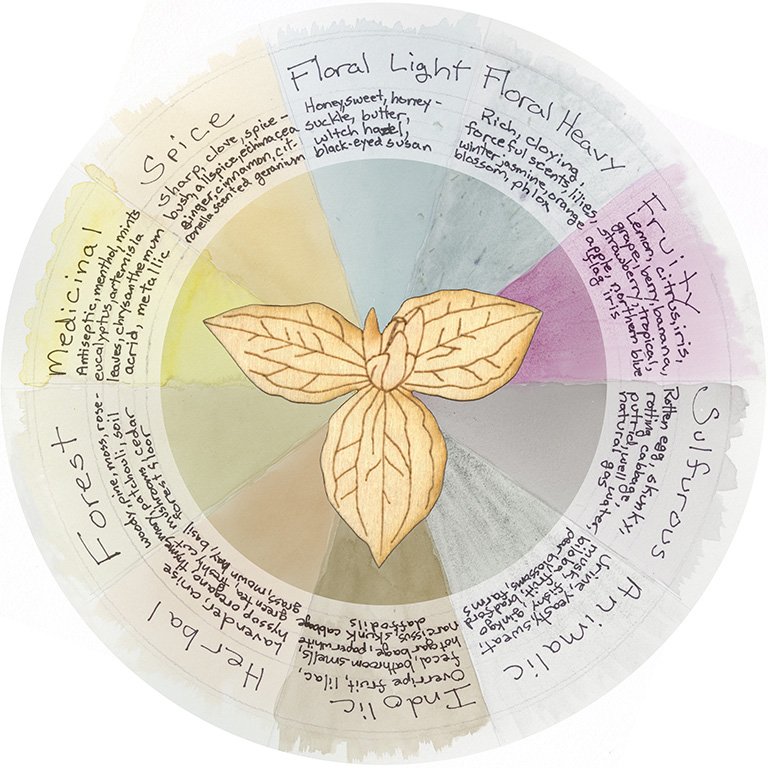
Rationale
- Native trillium are threatened with extinction due to human development and invasive species (predation and competition). Known as spring ephemerals, trillium are some of the first native wildflowers to emerge and bloom in the spring. Their early blooms are important for feeding early pollinators and supporting biodiversity.
- Trillium are distinctive for their unique and complex scents. Unlike many other flowers, trillium blooms span the botanical fragrance spectrum, smelling like cheese, wine, candy and dog food.
- Our project is seeking to reframe what many understand to be the traditional “smell of spring.” The traditional notion of the smell of spring consists of scents from plants that are non-native to the eastern United States. We are spreading awareness about the threats to the trillium flower by focusing on the smell of spring truly native to this region (our olfactory heritage!).
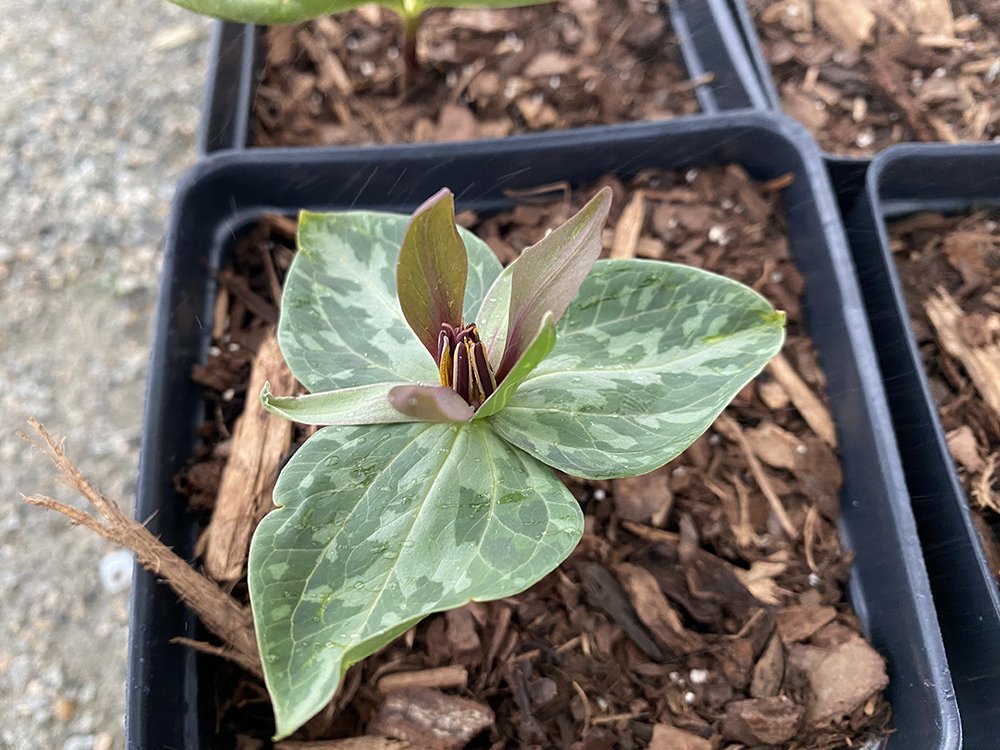
Location
Trillium can be found in eastern North America, the Pacific Northwest, and Eastern Asia. There are about 50 trillium species globally. However, the introduction of non-native species has threatened the trillium flower in our region.
Where to smell trillium in April:
- Mt. Cuba Center
- Bowman’s Hill Wildflower Preserve
- Chanticleer: A Pleasure Garden
- Rowan University - Glassboro Campus
Wheel design
The botanical inks used to create the hand painted smell wheel are made of foraged plant materials that symbolize the state of trillium in the Lenapehoking region. Scent, natural inks, and trillium are ephemeral mediums. The place-based color palette speaks to the trillium story: why they are vanishing and how to support conservation of this iconic spring ephemeral.
- Charcoal from the 2022 Wharton Forest Fire in South Jersey represents the changes in urban land use such as urbanization and regenerative forest management (or lack thereof) that threaten trillium habitat.
- English Ivy and Japanese Honeysuckle collected in Glassboro, NJ represent the threats trillium face from invasive plant competition and predation from the overpopulation of white-tailed deer.
- Food scraps such as pomegranate skin represent agricultural land use which reduces and can negatively impact trillium habitat.
- Pokeberry, a native plant, represents the critical role of native plants and ecological landscape practices in regenerating trillium habitat.
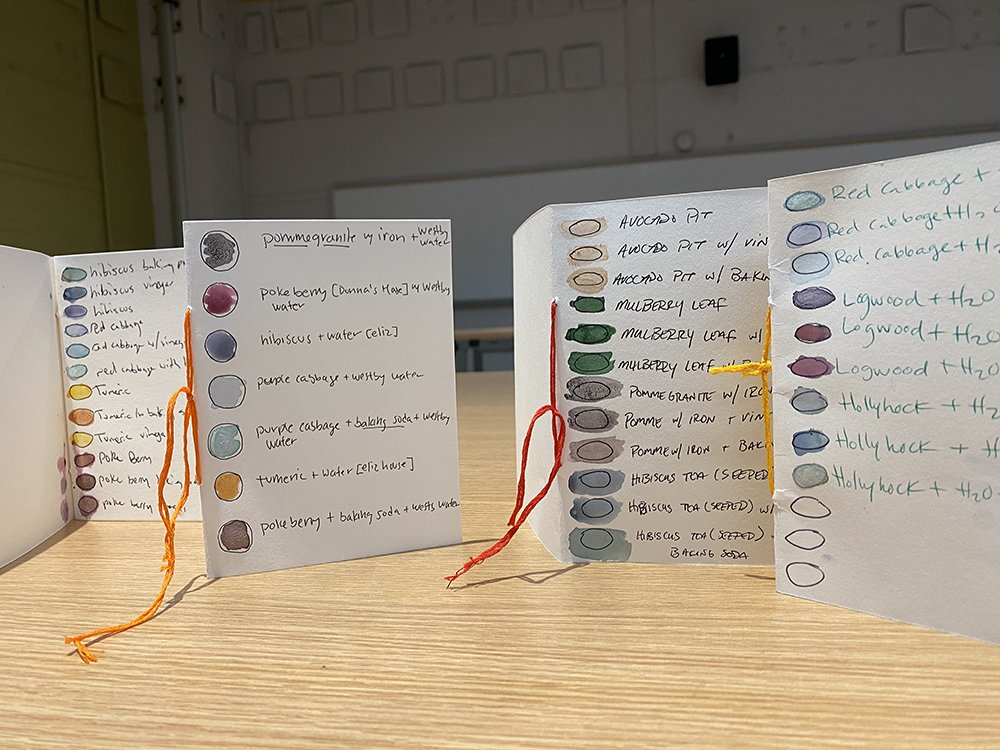
Acknowledgements
Special thanks to Dr. Robert Raguso at Cornell University for generously sharing his trillium research and enthusiasm with us; to Professors Tom Murray and Elizabeth Shores for horticultural support and botanical ink making, respectively; to Jim Greenwell and Lisa Toman for their fabrication and logistical support; to Iris Richardson and the Media Lab for digital design assistance; to Linda Walczak for partnering with us on aromatic native landscape design interventions and the Monell team for their ongoing chemosensory expertise and collaboration.

I’m a SMELL FAN. Are you?
Discover the 2022 Philadelphia Flower Show through scent using SMELL FAN, a handheld fan created by Rowan University in collaboration with the Monell Chemical Senses Center to circulate air and olfactory enthusiasm.
Explore your world with our botanical fragrance field guide, organized using ten categories adapted from Ken Druse’s book The Scentual Garden (an American Horticultural Society 2020 Award Winner) and crowd-sourced smell descriptions collected and mapped during the first outdoor Flower Show in 2021 by Rowan and Monell.
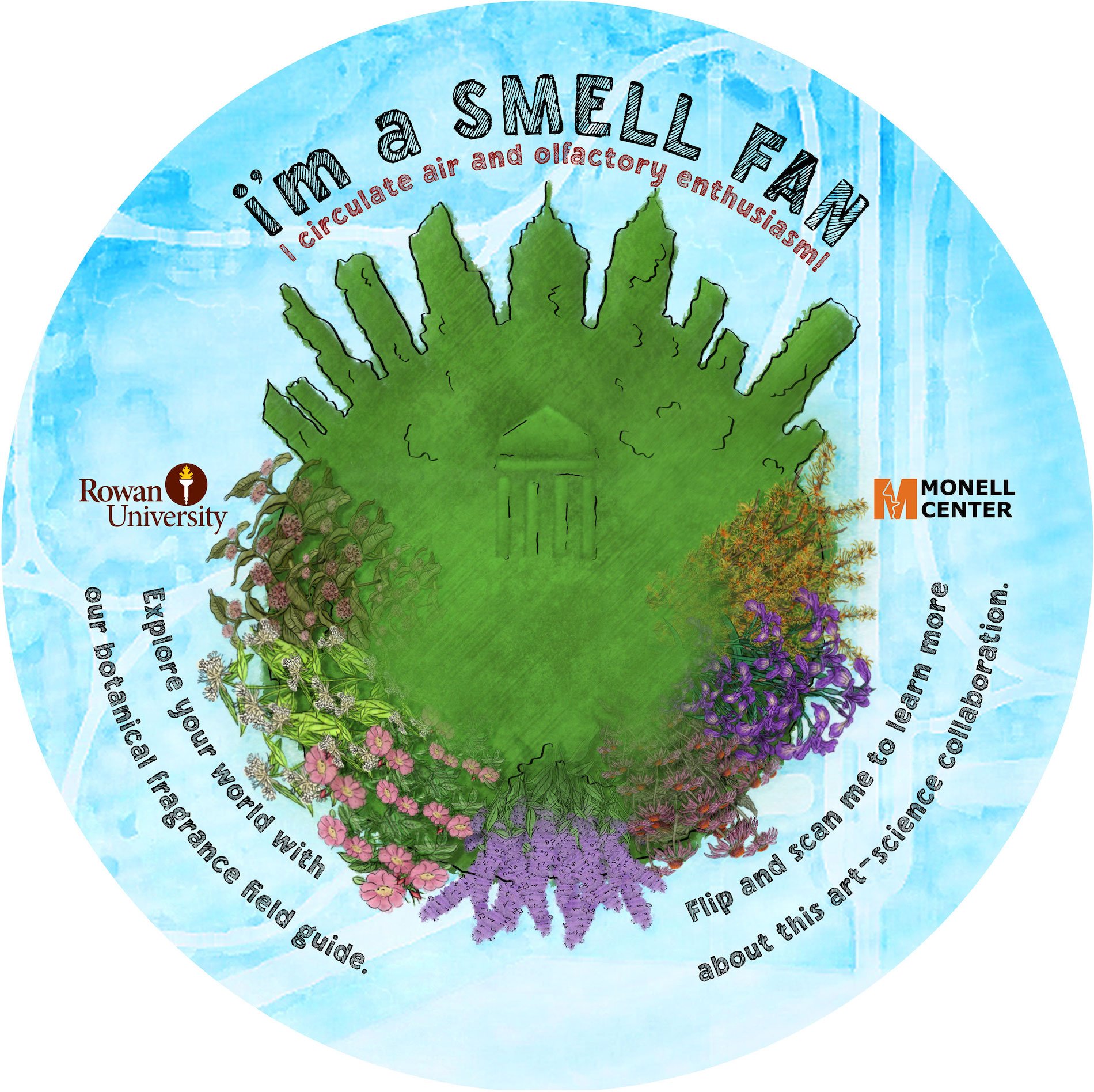
User Guide:
SMELL FAN is a conversation piece, an opening for talking about smell experience of all kinds, including smell memories and smell loss. Performatively proclaim your olfactory (smell) enthusiasm by outwardly facing the “i’m a SMELL FAN” side of the fan towards others. To learn more about the ways our sense of smell is critical to human health and well-being, visit the Monell Center.
SMELL FAN is a botanical fragrance field guide. Use it to describe and discuss your smell experience with plants at the Flower Show, on a sidewalk, in a park or garden. Can you locate and smell an aromatic plant in each of the ten categories at the Flower Show? Notice that each botanical fragrance category includes an aromatic native plant illustration. How many of these ten native pollinator plants can you find and smell today?
SMELL FAN is a handheld fan for moving aromatic air towards (or away) from yourself. Use it to stay cool on hot summer days and as a reminder to pause, sniff, and sense. What do you notice? Something? Follow the scent trail wherever it leads! Nothing? Find a plant, gently rub a leaf to release the aromatic oils. Sniff again. What do you smell? Use the descriptive examples to help discuss and categorize your smell experience or a smell memory.
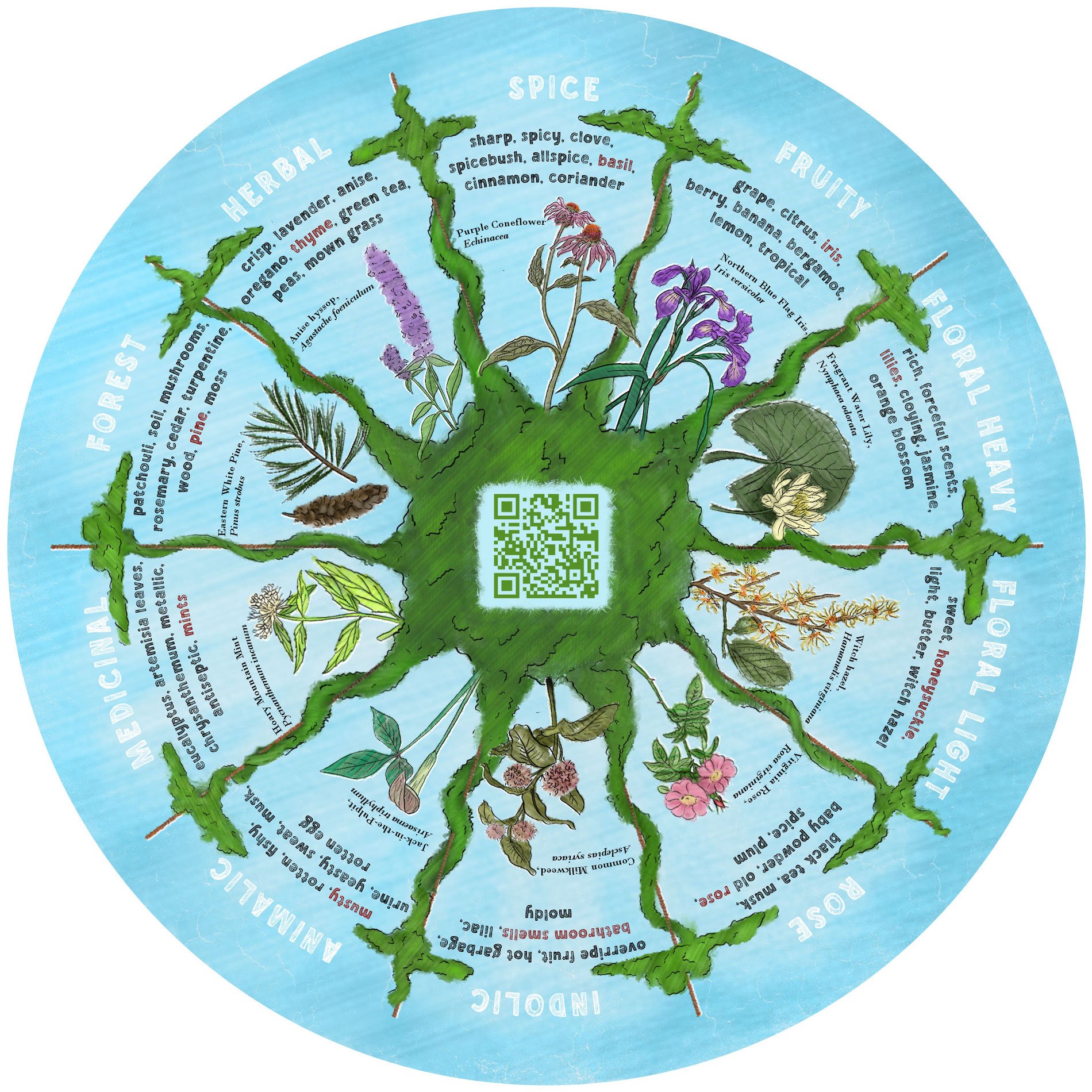
Project Goals:
This Rowan-Monell collaboration develops and applies arts-based public engagement strategies for the purpose of:
- understanding olfactory experience at the Philadelphia Flower Show and within urban and public spaces more broadly
- increasing awareness of the role of smell and smell loss in health and well-being
- inviting public audiences to participate in the science of smell, such as taking SCENTinel, a quick and easy patented smell test designed by Monell scientists.
- Creating undergraduate student research opportunities for creatively engaging with smell through an interdisciplinary lense
About this Project:
The Monell Center and academic affiliate Rowan University partnered on a sensory exploration and public engagement project at the 2021 Pennsylvania Horticultural Society Philadelphia Flower Show. Due to COVID-19 restrictions on indoor gatherings, the Flower Show was held outdoors for the first time in its history, with organizers transforming Philadelphia’s FDR Park into a spectacular exhibition themed “HABITAT: Nature’s Masterpiece.”
This project was conceived and implemented during the pandemic, when a heightened awareness of smell was becoming an integral part of our habitat, inside our homes and outside in nature. Outreach Monell staff, Karen Kreeger and Ahmed Barakat, collaborated with Dr. Jen Kitson, faculty in the Departments of Art and Geography, Planning and Sustainability at Rowan, to develop a sensory exploration of the Flower Show in her Smell Art Studio course. Three students in the Ric Edelman College of Communication and Creative Arts designed and implemented an interactive method for creatively engaging and educating the public about their smell experience at the first outdoor PHS Philadelphia Flower Show: Jennifer Araya (Graphic Design), Victoria Esquilin (Art Education) and Noel Waldron (PR & Art). We then invited visitors to engage the Flower Show through their noses, and record their smell experience on a large map of the exhibition using a custom sticker.

British artist Dr. Kate McLean worked with us on this project, offering guidance based on her extensive experience leading and mapping smell walks; Smell Art students and Monell staff undertook field research together at FDR Park using Dr. McLean’s Smellfie kit: A smell walking guide.

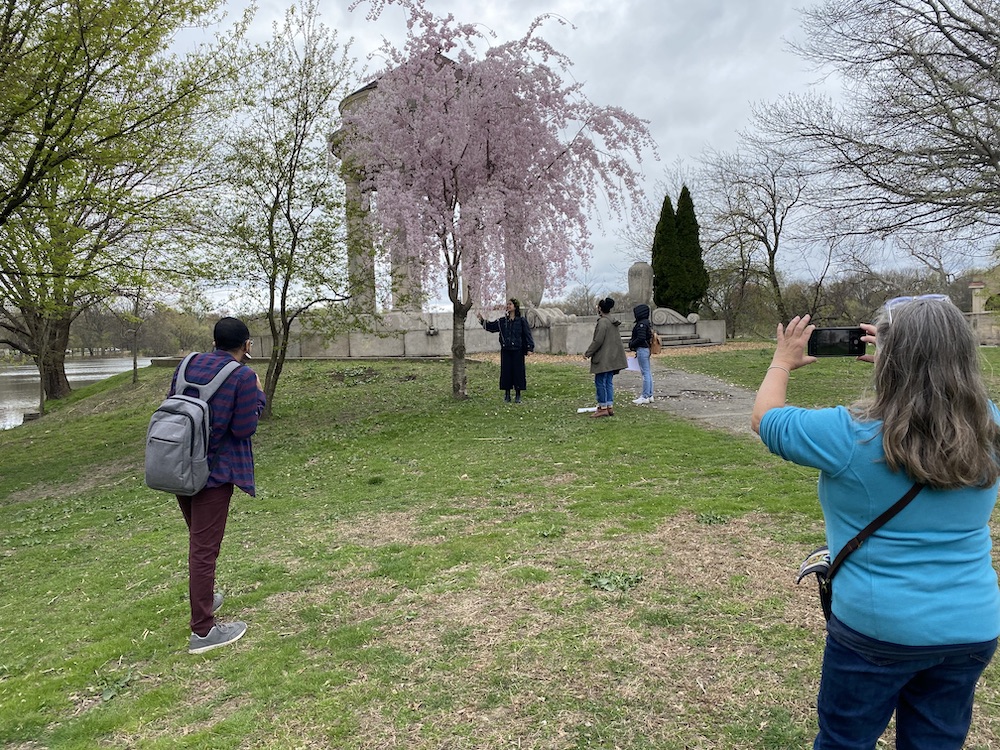
During the Spring 2022 semester, artist and jewelry professor Donna Sweigart joined the collaboration to work on visualizing the crowdsourced smell-map data into a “smell wheel,” a graphical convention for identifying and categorizing scent, which also doubles as a smell fan, a device for moving (scented) air. Handheld fans have served as both wearable art and jewelry and advertisement and communication objects, both of which we engaged in this project. Angela Ellsworth’s iconic smell art performance using a hand fan, titled Actual Odor (1997), was inspirational to SMELL FAN. Two undergraduate courses, Sweigart’s 3D Modeling for Artists and Designers Studio and Kitson’s Public Art and Social Practice Studio, were enlisted in researching the fan as a smell data visualization tool through creating fan prototypes using 3D printing and hand paper making. Undergraduate Graphic Design student Shayne Shands worked with Sweigart and Kitson on the development and design of the commercially printed SMELL FAN.
Shand’s original design is inspired by urban nature and place; Philadelphia’s skyline and the FDR park pergola are rendered in wild greenery, reminiscent of the kind that emerges from sidewalk cracks. The two outdoor PHS Flower Show themes: Habitat (2021) and Bloom (2022) are incorporated throughout the design through his illustrations of blooming aromatic native plants that offer an array of ecological services in our Mid-Atlantic region. For all-ages appeal at the Family Frolic Day, a hand-drawn urban sidewalk chalk style informs the font and background coloring of the fan.
Get Involved:
We’re always looking for new SMELL FANs! Interested in collaboration? Send us a note at kitson@rowan.edu and sweigart@rowan.edu. Visit https://monell.org/flowershow to continue learning about the science of smell.
Acknowledgements:
Support for this project was provided by a 2022 Edelman College of Communication and Creative Arts STORI Grant (Support for Teaching, Outreach and Research Innovations) and a 2021 IMMaD Grant (Institute of Innovative Media, Materials & Design).
We wish to express our appreciation for: Lori Marshal, Assistant Vice President,University Relations, for her feedback and support, Jim Greenwell, Art Technician for building our spinning smell wheel, 3D Modeling for Artists and Designers Studio and Public Art and Social Practice Studio students, and the CCCA marketing team.
SMELL FAN Field Research:
- Bowman’s Hill Wildflower Preserve, New Hope, PA
- Delaware Botanic Gardens, Dagsboro, DE
- Mt. Cuba Center, Hockessin, DE
SMELL FAN Reading List:
Druse, Ken. 2019. The Scentual Garden: Exploring the World of Botanical Fragrance . New York, NY: Abrams. [Rowan Libraries e-book]
Eierman, Kim. 2020. The Victory Pollinator Garden: Win the War on Pollinator Decline with Ecological Gardening. Beverly, MA: Quarry Books Inc.
Epstein, Catherine Haley. 2019. Nose Dive: A Book For the Curious Seeking Potential Through Their Noses. Pacific Northwest: Mindmarrow.
Haskell, David George. 2021. Thirteen Ways to Smell a Tree: Getting to Know Trees Through the Language of Scent. London, UK: Hachette.
Kimmer, Robin Wall. 2015. Braiding Sweetgrass: Indigenous Wisdom, Scientific Knowledge, and the Teachings of Plants. Minneapolis, MN: Milkweed.
Tallamy, Doug. 2020. Nature's Best Hope: A New Approach to Conservation that Starts in Your Yard. Portland, OR: Timber Press Inc.
Tsing, Anna Lowenhaupt. 2015. The Mushroom at the End of the World: On the Possibility of Life in Capitalist Ruins. Princeton, NJ: Princeton University Press.
Whittaker, Danielle. 2022. The Secret Perfume of Birds: Uncovering the Science of Avian Scent. Baltimore, MD: Hopkins Press.
